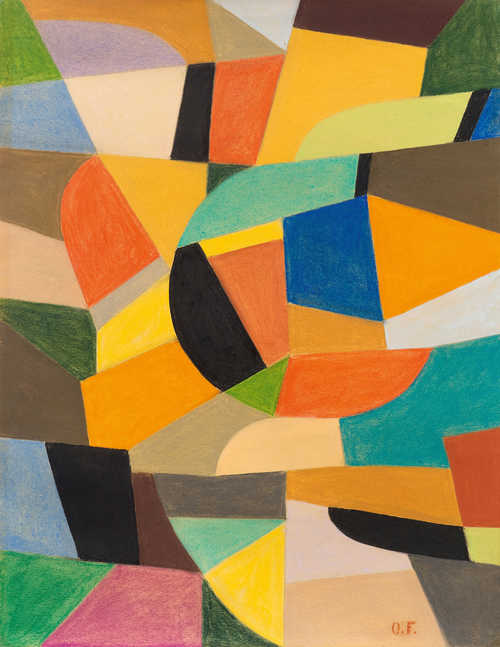
Lotto 3239 - A187 Impressionismo e arte moderna - venerdì, 07. dicembre 2018, 16h00
OTTO FREUNDLICH
Provenance:
- Galerie Schlegl, Zurich (with label on the reverse).
- Private collection Switzerland, purchased in 1992 at the above gallery.
“[…] The intimate connection of all surfaces in one picture, each of which, like one cell in an organism transfers energy to another cell so that there is only an unrestricted circulation of these forces in the whole organism; this was the only way to realise the collection of all colours in one picture. And that was the only goal I sought to achieve, as it was in line with my social conviction: socialism.
Therefore, I had to come step by step towards an ever stronger deindividualisation. I had to break the egocentric moment that is closely connected with the depiction of people, plants, and things; I had to come to a type of dialectic language of the colours themselves. I interconnected complexes of related colours, which in turn connected to complexes of other colour units and so on until the whole picture was closed. Each colour complex could contain its own highest colour dynamic, but bordered on all sides without gaps to the adjacent colour complexes, making the contrasts of the others and thereby their differences from them clearly visible; but since every colour complex was subject to the same law, an organism could be formed in which there was no individualism anymore, in that the whole richness of the colour scale could develop, without one colour unit living at the expense of another or oppressing it. Each colour complex, be it made up of strong reds or loud greys, holds its own next to the other; it retains its self only the stronger by accentuating the other. The coexistence of all these colour complexes, each of which representing a colour individuality, results in the perfect collective of all colours on one picture surface.” (Otto Freundlich in: Bekenntnisse eines revolutionären Malers, part 1)
The present work stems from Otto Freundlich's prolific period and is an excellent example of the artist's abstract work and tectonic colour painting. From the mid-1920s he moved to Paris, where he met the German actress and artist Jeanne (Hannah) Kosnick-Kloss in 1929. From that time onwards, Freundlich developed his own style of tectonic colour field painting, which subsequently pervaded throughout his entire oeuvre. He joined the artist group Abstraction-Création and together with his partner became a member of the Association des Ecrivains et Artistes Revolutionnaires. Otto Freundlich published several theoretical texts on abstract art and the "revolutionary painter,” in which he transferred his communist convictions to art and society.
Through the rise of the National Socialists, the Jewish-born Otto Freundlich was placed on the list of degenerate artists. His works were removed from all German museums and his sculpture Grosser Kopf (der neue Mensch) was placed on the title page of the “Entartete Kunst” (Degenerate Art) exhibition catalogue. During the war, Freundlich was interned in various transit camps in France and released. Later attempts to depart to the USA together with Kosnick-Kloss failed. In December 1942 Freundlich tried to escape the Jewish deportations by hiding with a neighbouring farmer. About two months later, Freundlich was caught and murdered in March 1943 in the Sobibor extermination camp.
CHF 15 000 / 25 000 | (€ 15 460 / 25 770)
Venduto per CHF 48 500 (incl. premio dell'acquirente)
Non si assume alcuna responsabilità per la correttezza di queste informazioni.
